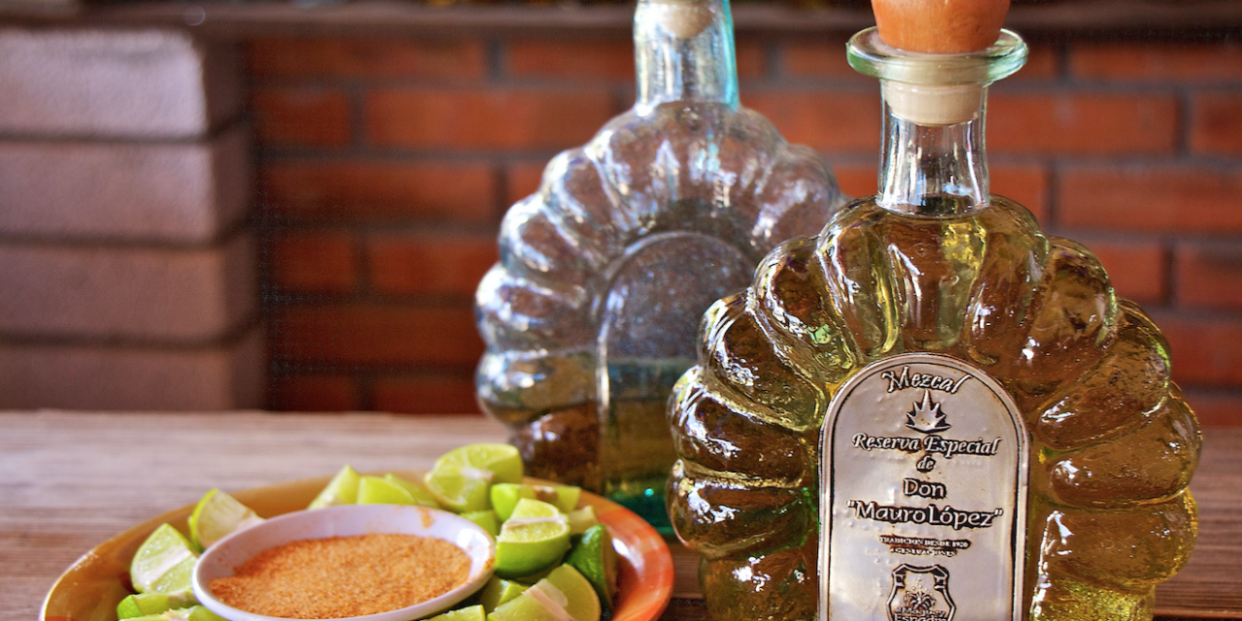Everything You Should Know Before Drinking Mezcal

As it's risen in popularity, mezcal has become known as tequila's smoky cousin. But there's a lot more to the spirit than just that—and we caught up with Gaston Martinez, founder of IZO Mezcal to learn more.
Gaston was born and raised in Durango, Mexico, where mezcal has a storied history—we're talking centuries long. It used to be a sort of outlawed spirit, much like moonshine in the American south. When mezcal came to the United States, it did so with a little kitsch, and Gaston wanted to prove it could be sophisticated, elegant, and chic. So, he created IZO.
When we caught up on the phone, he debunked more myths and shared more intel.
Traditionalists spell mezcal like it's pronounced.
That's m-e-s-c-a-l. (In Spanish, z's sound like s's.) So if you see "mescal" on a menu, don't roll your eyes: It's not a faux pas.
It's made from a plant you'll recognize.
Mezcal is a distilled spirit made from the agave plant, which is also how we get tequila. In short: You can blame agave for endless fun nights—and all the drunken texts you never meant to send. There are more than 200 types of agave plants, 45 to 50 of which are used to make mezcal, Gaston says. IZO is made with only wild agave, which tends to have a much stronger flavor. (Think of it like the farmers market version of produce versus what you get at the grocery store.)
Tequila is a type of mezcal.
Many people assume its the other way around, but that's not so. The word "mezcal" literally means "roasted agave," Gaston shares. So, tequila is a type of mezcal since any spirit made from agave is classified as such.
What is the difference between tequila and mezcal?
If you're looking to impress a drinker, memorize these.
1. They're produced in different regions.
Just like real champagne can only come from Champagne, France, and legit scotch is only made in Scotland, tequila and mezcal have regional distinctions. Oaxaca makes more than 90 percent of the world's mezcal supply. Durango is also famous for its mezcal production.
Jalisco is the epicenter of tequila production. "The tequila region, when they understood, they were like let's make our own little thing here," Gaston says.
2. They're made from different varieties of agave.
There are nearly 200 types of the plant, and mezcal can be made from more than 40 of them. As such, it can be a blend of two different varieties of agave plants, too—similar to a blend of different wine grapes. Tequila can only come from Blue Agave.
3. They're distilled differently.
The agave for tequila is steamed in ovens that are above ground. Mezcal producers use in-ground fire pits filled with wood and charcoal.
Because of all the above distinctions, Gaston says mezcals have a better chance of tasting multi-dimensional.
Mezcal doesn't have to taste like smoke.
Some bartenders feel the descriptor undercuts the spirit: Mezcal can taste a little charred because of the way it's produced, but you might also try some with floral, fruity, or earthy notes. A lot of it comes down to the specific agave plant—where it is, what variety it is, and when and how it was harvested.
Espadin mezcals are for beginners; then, graduate to tobalà.
Espadin agave is one of the most prevalent species of the plant, making it the most popular source of mezcal. Since it's so widespread, the taste can vary wildly from bottle to bottle. Tobalà is referred to as "the king of mezcals" because the agave plant is more scarce and harder to harvest. Read: That sh*t's expensive.
Mezcal is having a moment.
According to 2016 statistics, mezcal sales had doubled in the previous four years. The obsession is even boosting Oaxaca's economy, as investors and fans are flocking to the state.
The spirit is so popular, people are opening up bars dedicated to the stuff.
Mezcalito in San Francisco has more than 100 different bottles, which you can taste on their own in a flight or in a handful of cocktails. D.C.'s Espita Mezcaleria has a menu curated by one of the world's only Master Mezcaliers. In New York City, Casa Mezcal has three levels of bar space, each designed to evoke Oaxaca in the Big Apple.
You can't buy flavored mezcal.
The spirit isn't like vodka: It's not bottled to taste like pumpkin pie or strawberries. If you want it to taste differently, you'll need to mix it into a cocktail. (Or go to a mezcal bar, and have someone do it for you.)
One tequila brand is smoking its liquor to compete with mezcal.
Maestro Dobel Tequila, an 11th generation distillery, launched Humito, a smoked silver tequila. The genius behind the bottle says it's a riff on old-school tequila production, when they used to cook with agave with mesquite wood.
Forget everything you know about the worm in the bottle.
For starters, it's not even a worm, it's a larva—and it's a giant gimmick. Larvae really do find their way into agave plants (and therefore the spirits produced from them), but many American bars add the little guys to bottles just to boost sales. They're not a requirement or indication of good mezcal; if anything, they should deter you. As for the larvae's hallucinatory powers? That's complete BS.
Again, Gaston's mission with IZO was to stray from the gimmicky mezcals and bring something sophisticated to the U.S. You can find a list of stores (include Costco!) and restaurants and bars where IZO is sold on the brand's site, here. Every bottle comes with a unique, one-of-a-kind stopper.
You Might Also Like

